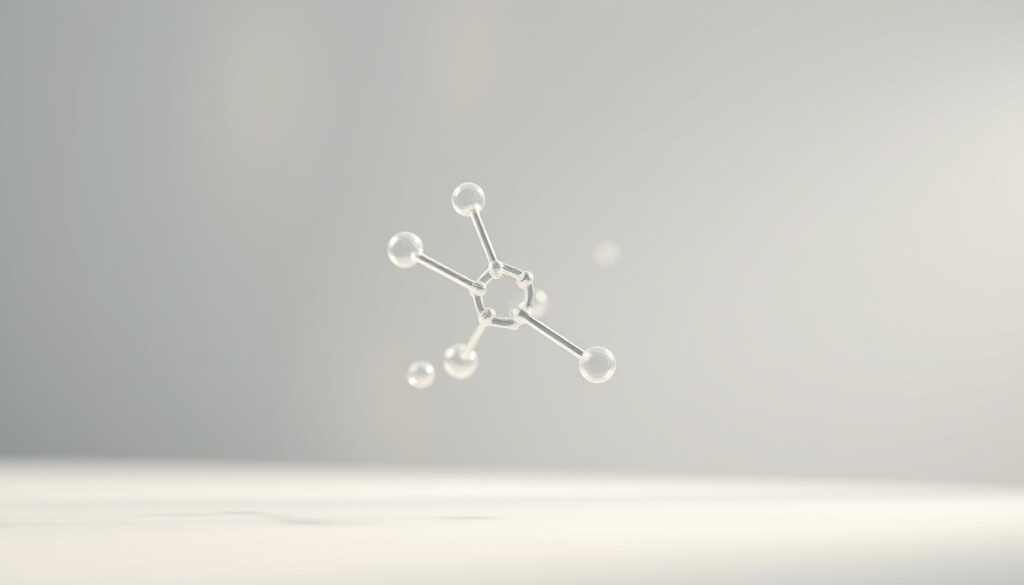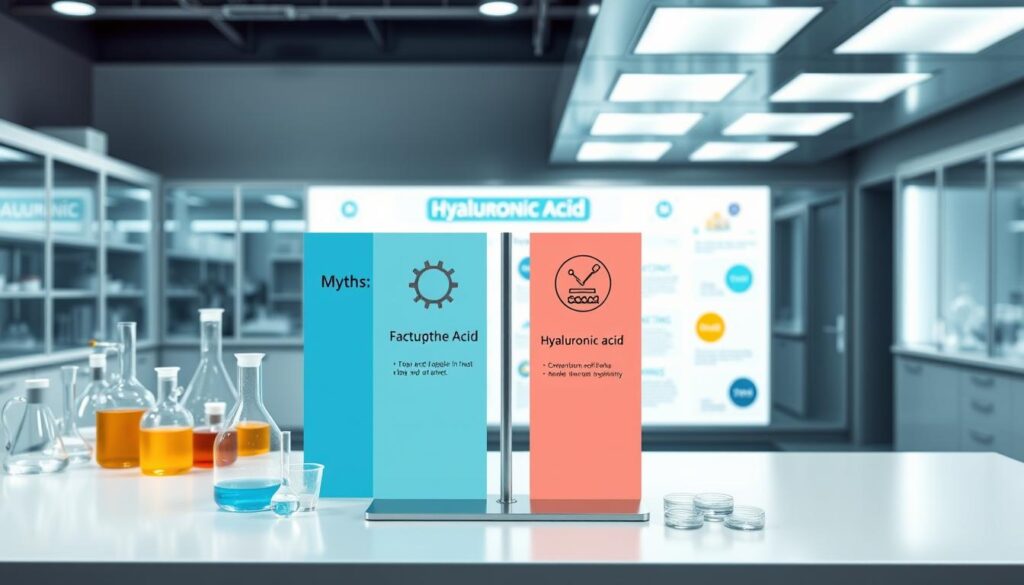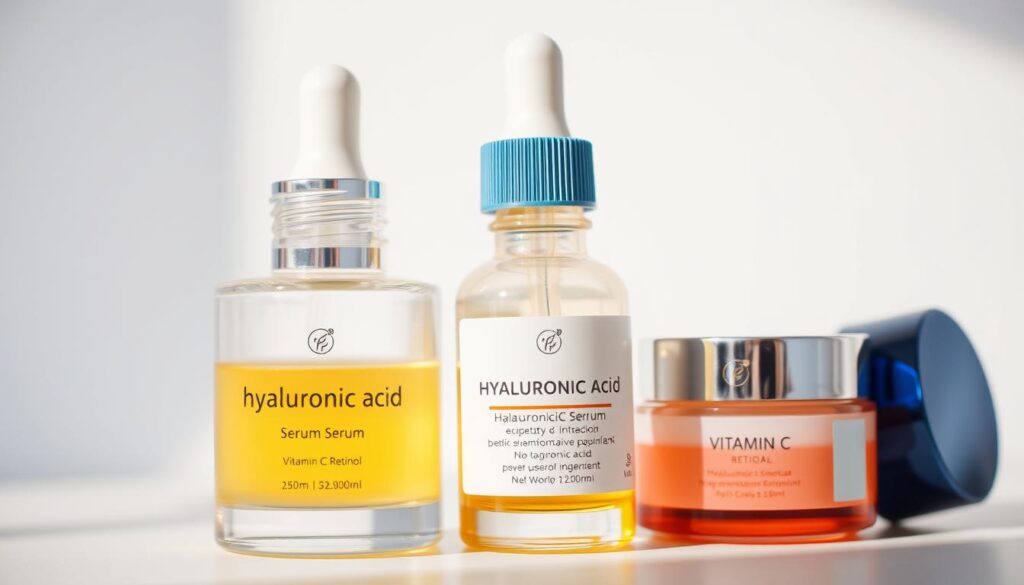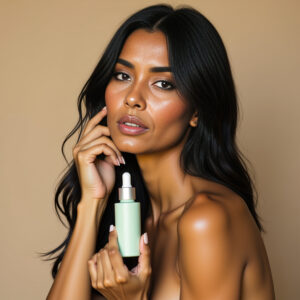Table of Contents
Have you ever wondered what makes hyaluronic acid so popular in beauty routines? This naturally occurring molecule is a powerhouse when it comes to hydration. Found in our skin and other tissues, it can hold up to 1,000 times its weight in water. That’s why it’s often called a moisture magnet.
Despite its widespread use, there are many misconceptions about this ingredient. Some believe it’s only for dry skin, while others think it’s a temporary fix. The truth? It’s a versatile component that benefits all skin types by maintaining elasticity and hydration.

What sets hyaluronic acid apart is its ability to bind water, keeping your skin plump and youthful. It’s not just a trend—it’s backed by science. Whether you’re new to it or a long-time user, understanding its true nature can help you make the most of its benefits.
Key Takeaways
- Hyaluronic acid is a naturally occurring molecule that holds immense amounts of water.
- It benefits all skin types by maintaining moisture and elasticity.
- Common myths about its use are often misleading—it’s more versatile than many think.
- Its ability to bind water makes it a key ingredient for a youthful appearance.
- Scientific research supports its effectiveness in hydration and skin health.
Understanding the Science Behind Hyaluronic Acid
The science behind this powerhouse ingredient is fascinating. At its core, it’s a naturally occurring molecule with a unique chain-like structure. This structure allows it to bind vast amounts of water, making it a hydration hero in beauty routines.
Molecular Structure and Water-Binding Capacity
What makes this ingredient so effective? Its molecular structure is the key. The molecule’s long chains create a sponge-like effect, holding up to 1,000 times its weight in water. This ability to retain moisture is what gives it its exceptional hydrating benefits.
Research shows that the molecule’s weight plays a crucial role in its performance. Lighter molecules penetrate deeper into the skin, while heavier ones stay on the surface, creating a protective barrier. This versatility makes it suitable for all skin types.
The Role in Skin Health and Wound Healing
Beyond hydration, this ingredient plays a vital role in skin health. It helps maintain elasticity, keeping skin plump and youthful. Studies also highlight its ability to support wound healing by promoting cell regeneration and reducing inflammation.
Here’s how it works at a cellular level:
- It attracts and retains water, keeping skin hydrated.
- It supports collagen production, improving skin elasticity.
- It accelerates wound healing by creating an optimal environment for cell repair.
“The molecule’s ability to bind water and support cellular repair makes it a cornerstone of modern skincare.”
Clinical trials have consistently shown its effectiveness. For example, one study found that regular use significantly improved skin hydration and elasticity in participants. These findings underscore its status as a trusted ingredient in both beauty and medical applications.
Common Myths vs. Facts About Hyaluronic Acid
There’s a lot of buzz about this molecule, but what’s fact and what’s fiction? Many skincare blogs exaggerate its effects, making it hard to separate truth from hype. Let’s dive into the most common misconceptions and uncover the evidence-based facts.

Debunking Misconceptions in Skincare
One widespread myth is that this ingredient only works for dry skin. In reality, it’s suitable for all skin types. Its lightweight molecules penetrate deeply, providing hydration without clogging pores. Another misconception is that it’s a temporary fix. Studies show that regular use improves skin appearance over time.
Evidence-Based Clarifications
Clinical research supports its effectiveness. For example, one study found that participants using serums with this ingredient experienced a 40% increase in skin hydration within four weeks. Here’s what the evidence tells us:
- It works in various products, from serums to creams, to enhance moisture retention.
- Its ability to bind water helps plump the skin, reducing the look of fine lines.
- It’s not just marketing—science backs its benefits for a healthier, more youthful appearance.
By understanding the facts, you can make informed choices and enjoy the real benefits of this versatile ingredient.
Benefits of Hyaluronic Acid in Skincare
Hydration is the cornerstone of healthy skin, and hyaluronic acid delivers it effortlessly. This powerful ingredient works wonders by locking in moisture, leaving your skin plump and radiant. Whether you’re dealing with dryness or just want to maintain a youthful glow, it’s a game-changer for all skin types.
Enhancing Hydration and Moisture Retention
One of the standout benefits of this ingredient is its ability to hold up to 1,000 times its weight in water. This means it deeply hydrates your skin, creating a lasting moisture barrier. When used in a product like a serum, it penetrates quickly, delivering hydration where it’s needed most.
Smoothing Fine Lines and Improving Elasticity
Fine lines and wrinkles can make skin look aged, but this ingredient helps smooth them out. By boosting moisture levels, it plumps the skin, reducing the appearance of lines. Over time, regular use can improve elasticity, giving your skin a firmer, more youthful look.
Strengthening the Skin Barrier
A strong skin barrier is essential for protecting against environmental stressors. This ingredient helps fortify the barrier by retaining moisture and supporting healthy cell function. When paired with the right ingredients, it can transform your skin’s resilience and appearance.
Here’s what you can expect from a quality hyaluronic acid serum:
- Deep hydration that lasts all day.
- Reduced visibility of fine lines and wrinkles.
- A stronger, more resilient skin barrier.
Choosing the right product with effective ingredients is key to unlocking these benefits. Whether you’re new to this ingredient or a long-time user, it’s a must-have for achieving healthy, glowing skin.
Hyaluronic acid skincare: How to Build an Effective Routine
Building a skincare routine with hyaluronic acid can transform your skin’s hydration game. The key is to choose the right products and layer them strategically for maximum benefits. By understanding how to use this ingredient effectively, you can create a routine that keeps your skin plump, hydrated, and glowing.
Selecting the Right Products
Not all hyaluronic acid products are created equal. The weight of the molecules plays a crucial role in how they work. Lighter molecules penetrate deeper into the skin, while heavier ones stay on the surface, creating a protective barrier. Look for products that combine multiple weights to target different layers of your skin’s body.
Here’s what to consider when choosing products:
- Opt for serums with low molecular weight for deep hydration.
- Use creams with higher molecular weight to lock in moisture on the surface.
- Combine products to create a multi-layered barrier effect.
Layering Serums and Moisturizers Strategically
Layering is essential for maximizing the benefits hyaluronic acid offers. Start with lightweight serums to hydrate deeper layers, then follow with thicker creams to seal in moisture. This approach ensures your skin stays hydrated throughout the day.
Here’s a simple layering strategy:
| Step | Product Type | Purpose |
|---|---|---|
| 1 | Low-weight serum | Deep hydration |
| 2 | Medium-weight essence | Mid-layer moisture |
| 3 | High-weight cream | Surface barrier |
By layering products this way, you create a strong barrier that protects your skin while keeping it hydrated. Remember to apply products to damp skin for better absorption.
With the right routine, you can unlock the full potential of hyaluronic acid. Focus on selecting products that work together and layer them strategically for glowing, healthy skin.
Types and Molecular Weights: Optimizing Your HA Benefits
Not all serums are created equal—understanding molecular weights can make all the difference. The size of the molecule determines how deeply it penetrates your skin and where it delivers its benefits hyaluronic acid is known for. By choosing the right type, you can target specific concerns like wrinkles or acne more effectively.
Low vs. High Molecular Weight Differences
Low molecular weight serums are smaller and can penetrate deeper into the skin. This makes them ideal for addressing fine wrinkles and boosting hydration at a cellular level. On the other hand, high molecular weight serums stay on the surface, creating a protective barrier that locks in moisture.
Here’s how they compare:
- Low weight: Targets deeper layers, reduces wrinkles, and hydrates from within.
- High weight: Forms a surface barrier, ideal for dry or acne-prone skin.
Combining Multiple Forms for Enhanced Efficacy
For balanced results, consider using both low and high molecular weight serums. Layering them allows you to hydrate deeply while protecting the surface. This approach is especially effective for addressing multiple concerns, like wrinkles and acne, in one routine.
Here’s how to combine them:
- Start with a low-weight acid serum for deep hydration.
- Follow with a high-weight serum to lock in moisture.
- Finish with a moisturizer to seal the benefits hyaluronic acid provides.
By understanding molecular weights and how to use them, you can unlock the full potential of your serum. Whether you’re targeting wrinkles or acne, the right combination can transform your skin’s hydration and appearance.
How Hyaluronic Acid Works with Other Skincare Ingredients
Combining ingredients in your routine can amplify their benefits—let’s explore how. When paired correctly, this powerhouse ingredient enhances hydration, boosts elasticity, and supports your skin’s natural renewal process. The key is to layer products strategically for maximum results.

Pairing with Antioxidants and Vitamins
Pairing this ingredient with antioxidants and vitamins can supercharge your routine. Antioxidants like vitamin C protect your skin from environmental damage, while vitamins like B5 soothe and repair. Together, they reduce moisture loss and improve elasticity, giving your skin a healthy, youthful glow.
Here’s how it works:
- Antioxidants neutralize free radicals, preventing damage.
- Vitamins support cell repair and hydration.
- This ingredient locks in moisture, creating a protective barrier.
Integrating Actives Without Overwhelming the Skin
Adding active ingredients to your routine doesn’t have to be overwhelming. The key is to introduce them gradually and layer them effectively. For example, start with a lightweight serum, followed by a moisturizer to seal in the benefits. This process ensures your skin stays balanced and hydrated.
Here are some tips for integrating actives:
- Use gentle formulas to avoid irritation.
- Layer products from thinnest to thickest consistency.
- Monitor your skin’s response and adjust as needed.
By combining this ingredient with other actives, you can create a treatment that addresses multiple concerns. Whether you’re targeting dryness, fine lines, or uneven texture, the right pairings can transform your skin. For people looking to enhance their routine, this approach offers a simple yet effective solution.
Potential Side Effects and Safe Usage Guidelines
While hyaluronic acid is widely praised, it’s essential to know how to use it safely. Incorrect concentrations or unsuitable molecular weights can lead to irritation. That’s why formulations must be carefully designed to maximize benefits while minimizing risks.
Understanding Concentration and Molecular Implications
Using hyaluronic acid effectively starts with understanding its concentration and molecular weight. For example, higher concentrations may not always be better—they can overwhelm the skin barrier and cause redness or dryness. Similarly, molecular weight determines how deeply it penetrates the skin surface.
Here’s what to keep in mind:
- Low molecular weights hydrate deeper layers, ideal for reducing fine lines.
- High molecular weights create a protective barrier on the skin surface.
- Balanced formulations combine both for comprehensive hydration.
Identifying Signs of Irritation or Inflammation
Even with proper use, some people may experience mild irritation. Signs include redness, itching, or a burning sensation. If this happens, reduce usage or switch to a lower concentration. Always patch-test new products to ensure compatibility with your skin barrier.
Here’s how to manage irritation:
- Start with a lower concentration and gradually increase.
- Pair with soothing ingredients like aloe vera or ceramides.
- If irritation persists, consult a dermatologist.
Choosing trusted products is key to minimizing risks. Look for formulations that balance concentration and molecular weight to address fine lines without compromising your skin barrier. With the right approach, you can enjoy the benefits of using hyaluronic acid safely and effectively.
Scientific Research and Emerging Trends in Hyaluronic Acid
Recent breakthroughs in scientific research are shedding new light on the versatile applications of hyaluronic acid. From clinical studies to innovative treatments, this ingredient continues to redefine skincare and medical practices. Let’s explore the latest findings and what they mean for the future.

Clinical Studies on Skin Elasticity and Hydration
Clinical trials have consistently demonstrated the effects of hyaluronic acid on skin elasticity and hydration. One study found that participants using HA-based products experienced a 40% improvement in skin moisture levels within four weeks. Another study highlighted its ability to reduce the appearance of fine lines by up to 30%.
Here’s what the research tells us:
- HA fillers restore skin volume, making them a popular choice for reducing wrinkles.
- Its water-binding properties enhance hydration, improving skin texture and elasticity.
- Regular use can lead to long-term benefits, not just temporary fixes.
Future Directions in HA-Based Treatments
Emerging trends are pushing the boundaries of how we use hyaluronic acid. Researchers are exploring new formulations that combine HA with other active ingredients for enhanced results. For example, pairing it with peptides or growth factors could amplify its anti-aging effects.
Here’s a glimpse into the future:
| Trend | Potential Benefit |
|---|---|
| HA + Peptides | Boosts collagen production and reduces wrinkles |
| HA + Growth Factors | Accelerates skin repair and renewal |
| HA + Antioxidants | Protects against environmental damage |
While these advancements are exciting, it’s important to consider potential side effects. Some formulations may cause mild irritation, especially for sensitive skin. Always patch-test new products and consult a dermatologist if needed.
By staying informed about the latest research, you can make smarter choices about how to use hyaluronic acid in your routine. Whether you’re exploring fillers or trying new treatments, science-backed insights can guide you toward healthier, more radiant skin.
Conclusion
When it comes to maintaining a healthy glow, few ingredients are as effective as this moisture magnet. Its ability to bind water molecules makes it a standout choice for those looking to hydrate skin and improve the appearance of their face. Proper care and a balanced routine can maximize its benefits, ensuring your skin stays plump and radiant.
Understanding both the advantages and potential side effects is key. By incorporating this ingredient thoughtfully, you can protect against moisture loss and achieve long-term vitality. Hyaluronic acid also works well with other products, making it a versatile addition to any routine.
Ready to transform your skin? Seek out products that leverage the power of this ingredient for a healthier, more youthful look. With the right approach, you can unlock its full potential and enjoy glowing results.




